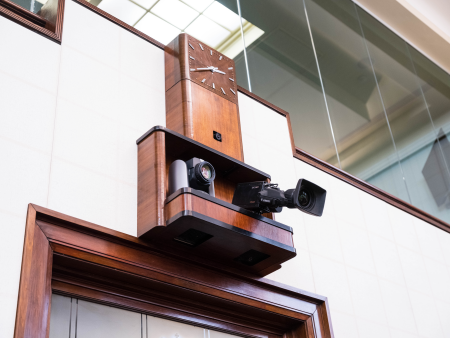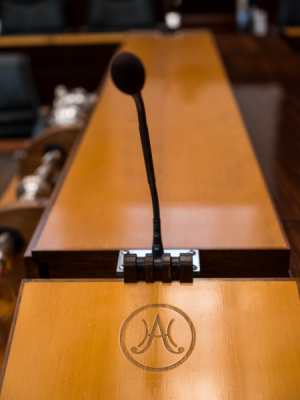 House of Assembly Education Office
House of Assembly Education Office
Watch, Listen and Read
The expansion of digital technologies into the Parliament of Tasmania gives Tasmanian schools greater access to their Parliament. This can be in the form of a live stream (webcast), video on demand (archived webcast) or as a written transcript (Hansard). Modern parliamentary broadcast services give teachers flexibility in accessing Parliament at a time that suits their class.
Watch and Listen

Cameras for live streaming
The Parliament of Tasmania broadcasts the House of Assembly and the Legislative Council procedures on the Parliament’s website. The House of Assembly Order of Business provides a guide to a House sittings day. Many Parliamentary Committees also broadcast their hearings.
To watch Parliament live:
Click on the House of Assembly webcast or the Legislative Council webcast.
To watch Parliament on demand:
First click on the House of Assembly Chamber Proceedings or the Legislative Council Proceedings, then on the relevant date. The video tab will appear.
Read

Hansard microphone at the lectern
Hansard is the official transcript of Parliament.
During parliamentary sittings, debates are recorded, transcribed and edited by the specialist staff of Hansard. Hansard transfer the spoken word to written word as accurately as possible. There is some editing to remove obvious mistakes or unnecessary repetitions, without taking away from, or changing the Member’s meaning or intent. Members of Parliament receive draft versions of Hansard, known as the ‘Daily Hansard’ and Members may suggest corrections.
The process of editing Hansard requires strict attention to detail, sophisticated writing skills and a deep understanding of Parliamentary procedures and vocabulary. Given the editing and proofreading required to publish Hansard, there is a delay between the delivery of a speech by a Member in the Chamber and the publication of the speech in Hansard.
In addition, all the Votes and Proceedings of the Parliament of Tasmania are recorded in Hansard.
Tips for teachers planning Civics and Citizenship units of work
While the business of the Parliament of Tasmania is always subject to change, the following tips may help teachers streamline their Civics and Citizenship planning.
When?
Plan using the current Sitting Schedule
The Sitting Schedule is the calendar of meeting dates of each House.
Cross-reference the Parliament’s sitting times with school timetables
For classes planning to watch Parliament live, the House of Assembly sits from 10am and the Legislative Council usually from 11am. Both Houses rise for a lunch break from 1 pm to 2:30 pm. The Order of Business papers list the proposed daily agenda of the House of Assembly and the Legislative Council.
What?
Study the Notices of Motion Papers
The House of Assembly Notice Paper and the Legislative Council Notice Paper, list the business before each House. This paper allows motions, or formal proposals, to ‘mature’, in order that Members may consider their position and contribution when the motion is eventually moved within either Chamber.
The Notice Papers allow all Tasmanians, including teachers, to know the upcoming business before the Parliament of Tasmania.
Follow the passage of a Bill
To understand the requirements for a Bill to become an Act of Parliament, students may benefit from following a Bill through the three reading process in both Houses. A natural starting point for teachers and students, is to identify a Bill that is of high interest to students or is directly set in the curriculum. The list of the Bills currently before Parliament is available on the Parliament of Tasmania website. Clicking on a Bill displays the progress of the Bill through each House. To watch or read a particular debate, the Chamber Proceedings links of both Houses, will give teachers access to the archived webcast or Hansard.
The Votes and Proceedings search option allows students to see some of the more technical procedures of the Parliament, including the results of any divisions.
For more information contact the House of Assembly Education Office.
